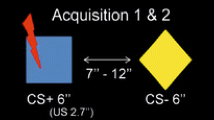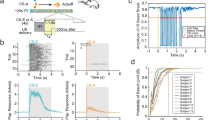Abstract
It has become clear from the study of different response systems during classical conditioning that some responses are acquired quite rapidly and others show a much slower rate of acquisition. The most often studied rapidly acquired responses have been classically conditioned autonomic changes (e.g., heart rate); the slowly acquired responses most often studied are skeletal responses, such as the eyeblink or leg flexion response. Although there are various other differences between rapidly acquired and slowly acquired responses, we have suggested that the most important difference is the possibility that they represent different stages of the learning process. In the present review I describe research in our laboratory that has focused on conditioned bradycardia as a model system of a rapidly acquired associative system and contrast it with the more slowly acquired Pavlovian conditioned eyeblink response. I also describe the generality of conditioned bradycardia and discuss the differential role of subdivisions of the prefrontal cortex as a substrate for mediating this response. Finally, I briefly discuss the other brain areas involved in conditioned bradycardia, and its functional significance as it relates to the learning process.
Similar content being viewed by others
References
Albiniak, B. A., & Powell, D. A. (1980). Peripheral autonomic mechanisms and Pavlovian conditioning in the rabbit (Oryctolagus Cuniculus).Journal of Comparative and Physiological Psychology, 94: 1101–13.
Bard, P., & Mountcastle, V. B. (1948). Some forebrain mechanisms involved in expression of rage with special reference to suppression of angry behavior.Research Publications of the Association of Nervous and Mental Diseases, 27: 362–404.
Buchanan, S. L. (1991). Differential and reversal Pavlovian conditioning in rabbits with mediodorsal thalamic lesions: Assessment of heart rate and eyeblink responses.Experimental Brain Research, 86: 174–81.
Buchanan, S. L., & Powell, D. A. (1982a). Cingulate cortex: Its role in Pavlovian conditioning.Journal of Comparative and Physiological Psychology, 96: 755–74.
Buchanan, S. L., & Powell, D. A. (1982b). Cingulate damage attentuates conditioned bradycardia.Neuroscience Letters, 29: 261–68.
Buchanan, S. L., & Powell, D. A. (1989). Parasagittal thalamic knife cuts and cardiac changes.Behavioural Brain Research, 32: 241–53.
Buchanan, S. L., Thompson, R. H., Maxwell, B. L., & Powell, D. A. (1994). Efferent connections of the medial prefrontal cortex in the rabbit.Experimental Brain Research, in press.
Buchanan, S. L., Valentine, J. D., & Powell, D. A. (1985). Autonomic responses are elicited by electrical stimulation of the medial but not lateral frontal cortex in rabbits.Behavioural Brain Research, 18: 51–62.
Clugnet, M., & LeDoux, J. E. (1990). Synaptic plasticity in fear conditioning circuits: Induction of LTP in the lateral nucleus of the amygdala by stimulation of the medial geniculate body.Journal of Neuroscience, 10: 2818–24.
Clugnet, M., LeDoux, J. E., & Morrison, S. F. (1990). Unit responses evoked in the amygdala and straitum by electrical stimulation of the medial geniculate body.Journal of Neuroscience, 10, 1055–61.
De Wied, D. (1980). Behavioral actions of neurohypophysial peptides. In A. Burgen, H. W. Kosterlitz, & L. L. Iversen (Eds.),Neuroactive Peptides. London: Royal Society, pp. 183–94.
Fehr, F. S., & Stern, J. A. (1970). Peripheral physiological variables and emotion: The James-Lange theory revisited.Psychological Bulletin, 74: 411–24.
Frysztak, R. J., & Neafsey, E. J. (1991). The effect of medial frontal cortex lesions on respiration “freezing,” and ultrasonic vocalizations during conditioned emotional responses in rats.Cerebral Cortex, 1: 418–25.
Fuster, J. M. (1989). The Prefrontal Cortex: Anatomy, Physiology and Neuropsychology of the Frontal Lobe. 2d ed. New York: Raven Press.
Gantt, W. H. (1960). Cardiovascular component of the conditional reflex to pain, food, and other stimuli.Physiological Review, 40: 266–91.
Gibbs, C. M., & Powell, D. A. (1988). Neuronal correlates of classically conditioned bradycardia in the rabbit: Studies of the medial prefrontal cortex.Brain Research, 442: 86–96.
Gibbs, C. M., & Powell, D. A. (1991). Single-unit activity in the dorsomedial prefrontal cortex during the expression of discriminative bradycardia in rabbits.Behavioural Brain Research, 43: 79–92.
Gormezano, I. (1972). Investigations of defense and reward conditioning in the rabbit. In A. H. Black & W. F. Prokasy (Eds.),Classical Conditioning II: Current Research and Theory. New York: Appleton-Century-Crofts, pp. 151–81.
Gray, J. A. (1982).The Neuropsychology of Anxiety: An Inquiry into the Functions of the Septo-hippocampal System. New York: Oxford University Press.
Hurley, K. M., Herbert, H., Moga, M. M., & Saper, C. B. (1991). Efferent projections of the infralimbic cortex of the rat.Journal of Comparative Neurology, 308, 249–76.
Jarrell, T. W., Gentile, C. G., McCabe, P. M., & Schneiderman, N. (1986). The role of the medial geniculate region in differential Pavlovian conditioning of bradycardia in rabbits.Brain Research, 374: 126–36.
Kao, K., & Powell, D. A. (1988). Lesions of the substantia nigra retard Pavlovian eyeblink but not heart rate conditioning in the rabbit.Behavioral Neuroscience, 102: 515–25.
Kapp, B. S., Frysinger, R. C., Gallagher, M., & Haselton, J. R. (1979). Amygdala central nucleus lesions: Effect on heart rate conditioning in the rabbit.Physiology & Behavior, 23: 1109–17.
Kapp, B. S., & Pascoe, J. P. (1986). Memory: Vertebrate model systems. In J. L. Martinez, & R. P. Kesner (Eds.),Learning and Memory: A Biological View. New York: Academic Press, pp. 299–340.
Kapp, B. S., Schwaber, J. S., & Driscoll, P. A. (1985). Frontal cortex projections to the amygdaloid central nucleus in the rabbit.Neuroscience, 15: 327–46.
Kazis, E., Milligan, W. L., & Powell, D. A. (1973). Autonomic-somatic relationships: Blockade of heart rate and corneoretinal potential.Journal of Comparative Physiological Psychology, 84: 98–110.
Konorski, J. (1967).Integrative Activity of the Brain. Chicago: University of Chicago Press.
Lacey, B. C., & Lacey, J. I. (1974). Studies of heart rate and other bodily processes in sensorimotor behavior. In P. A. Obrist, A. H. Black, J. Brener, & L. V. DiCara (Eds.),Cardiovascular Psychophysiology: Current Issues in Response Mechanisms, Biofeedback, and Methodology. Chicago: Aldine, pp. 538–64.
Laroche, S., Jay, T. M., & Thierry, A. (1990). Long-term potentiation in the prefrontal cortex following stimulation of the hippocampal CA1/subicular region.Neuroscience Letters, 114: 184–90.
Lavond, D. G., Lincoln, J. S., McCormick, D. A., & Thompson, R. F. (1984). Effect of bilateral lesions of the dentate and interpositus cerebellar nuclei on conditioning of heart-rate and nictitating membrane/eyelid responses in the rabbit.Brain Research, 305: 323–30.
LeDoux, J. E., Cicchetti, P., Xagoraris, A., & Romanski, L. M. (1990). The lateral amygdaloid nucleus: sensory interface of the amygdala in fear conditioning.Journal of Neuroscience, 10: 1062–69.
Lennartz, R. C., & Weinberger, N. M. (1992). Analysis of response systems in Pavlovian conditioning reveals rapidly versus slowly acquired conditioned responses: Support for two factors, implications for behavior and neurobiology.Psychobiology, 20: 93–119.
Martinez, J. L., Jr. (1986). Memory: Drugs and hormones. In J. L. Martinez, Jr., & R. P. Kesner (Eds.),Learning and Memory: A Biological View. Orlando: Academic Press, pp. 127–63.
Maxwell, B., Powell, D. A., & Buchanan, S. L. (1994). Multiple and single unit activity in area 32 (prelimbic region) of the medial prefrontal cortex during Pavlovian heart rate conditioning in the rabbit.Cerebral Cortex, in press.
McCormick, D. A., & Thompson, R. F. (1984). Cerebellum: Essential involvement in the classically conditioned eyelid response.Science, 223: 296–99.
McDonald, A. J. (1991). Organization of amygdaloid projections to the prefrontal cortex and associated striatum in the rat.Neuroscience, 44: 1–14.
McEchron, M. D., McCabe, P. M., Green, E. J., Llabre, M. M., & Schneiderman, N. (1991). Air puff versus shock unconditioned stimuli in rabbit heart rate conditioning.Physiology & Behavior, 51: 195–99.
McGaugh, J. L. (1990). Significance and remembrance: The role of neuromodulatory systems.Psychological Science, 1: 15–25.
Neafsey, E. J., Hurley-Guis, K. M., & Arvanitis, D. (1986). The topographical organization of neurons in the rat medial frontal, insular and olfactory cortex projecting to the solitary nucleus, olfactory bulb, periaqueductal gray and superior colliculus.Brain Research, 377: 261–70.
Ohman, A. (1988). Nonconscious control of autonomic responses: A role for Pavlovian conditioning?Biological Psychology, 27: 113–35.
Powell, D. A. (1979). Peripheral and central muscarinic cholinergic blockade: Effects on Pavlovian conditioning.Bulletin of Psychonomic Society, 14: 161–64.
Powell, D. A., Buchanan, S. L., & Gibbs, C. M. (1990). Role of the prefrontal-thalamic axis in classical conditioning. In H. B. M. Uylings, C. G. Van Eden, J. P. C. De Bruin, M. A. Corner, & M. G. P. Feenstra (Eds.),The Prefrontal Cortex: Its Structure, Function and Pathology, Progress in Brain Research, vol. 85. Amsterdam: Elsevier Science, pp. 433–66.
Powell, D. A., Gibbs, C. M., Maxwell, B., & Levine-Bryce, D. (1993). On the generality of conditioned bradycardia in rabbits: Assessment of CS and US modality.Animal Learning and Behavior, 21, 303–313.
Powell, D. A., & Kazis, E. (1976). Blood pressure and heart rate changes accompanying classical eyeblink conditioning in the rabbit (Oryctolagus Cuniculus).Psychophysiology, 13: 441–47.
Powell, D. A., & Levine-Bryce, D. (1988). A comparison of two model systems of associative learning: Heart rate and eyeblink conditioning in the rabbit.Psychophysiology, 25: 672–82.
Powell, D. A., Lipkin, M., & Milligan, M. L. (1974). Concomitant changes in classically conditioned heart rate and corneoretinal potential discrimination in the rabbit (Oryctolagus cuniculus).Learning and Motivation, 5: 532–47.
Powell, D. A., Mankowski, D., & Buchanan, S. L. (1978). Concomitant heart rate and corneoretinal potential conditioning in the rabbit (Oryctolagus Cuniculus): Effects of caudate lesions.Physiology & Behavior, 20: 143–50.
Powell, D. A., & Mulligan, W. L. (1975). Effects of partial and continuous reinforcement on conditioned heart rate and corneoretinal potential responses in the rabbit (Oryctolagus cuniculus).The Psychological Record, 25: 419–26.
Powell, D. A., Watson, K., & Maxwell, B. (1994). Involvement of subdivisions of the medial prefrontal cortex in learned cardiac adjustments.Behavioral Neuroscience, in press.
Schneiderman, N. (1972). Response system divergencies in aversive classical conditioning. In A. H. Black & W. F. Prokasy (Eds.),Classical Conditioning II: Current Theory and Research. New York: Appleton-Century-Crofts, pp. 341–76.
Schneiderman, N., & Gormezano, I. (1964). Conditioning of the nictitating membrane of the rabbit as a function of CS-US interval.Journal of Comparative and Physiological Psychology, 57: 188–95.
Schneiderman, N., McCabe, P. M., Haselton, J. R., Ellenberger, H. H., Jarrell, T. W., & Gentile, C. G. (1987). Neurobiological bases of conditioned bradycardia in rabbits. In I. Gormezano, W. F. Prokasy, & R. F. Thompson (Eds.),Classical Conditioning. 3d ed. Hillsdale, NJ: Lawrence Erlbaum, pp. 37–63.
Supple, W. F., Jr., & Leaton, R. N. (1990). Cerebellar vermis: Essential for classically conditioned bradycardia in the rat.Brain Research, 509: 17–23.
Supple, W. F., Archer, L., & Kapp, B. S. (1989). Lesions of the cerebellar vermis severely impair acquisition of Pavlovian conditioned bradycardiac responses in the rabbit.Society for Neuroscience Abstracts, 15: 640.
Van Der Kooy, D., Koda, L. Y., McGinty, J. F., Gerfen, C. R., & Bloom, F. E. (1984). The organization of projections from the cortex, amygdala, and hypothalamus to the nucleus of the solitary tract in rat.Journal of Comparative Neurology, 224: 1–24.
Yeo, C. H., Hardiman, M. J., & Glickstein, M. (1984). Discrete lesions of the cerebellar cortex abolish the classically conditioned nictitating membrane response of the rabbit.Behavioural Brain Research, 13: 261–66.
Author information
Authors and Affiliations
Rights and permissions
About this article
Cite this article
Powell, D.A. Rapid associative learning: Conditioned bradycardia and its central nervous system substrates. Integrative Physiological and Behavioral Science 29, 109–133 (1994). https://doi.org/10.1007/BF02691009
Issue Date:
DOI: https://doi.org/10.1007/BF02691009




